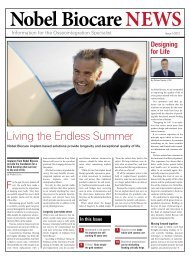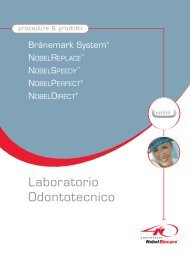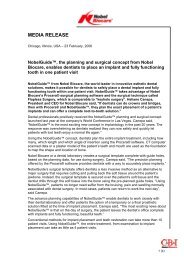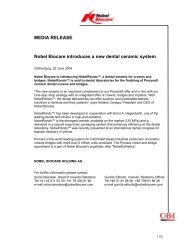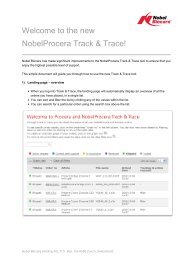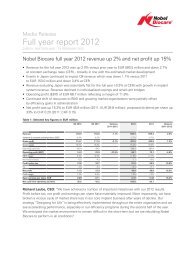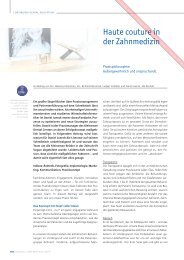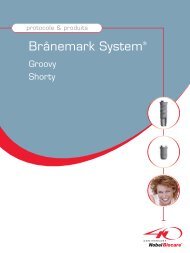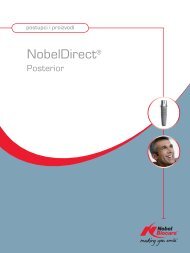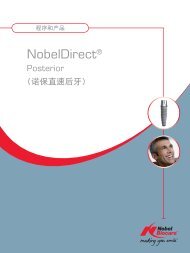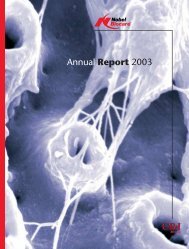clinical - Nobel Biocare
clinical - Nobel Biocare
clinical - Nobel Biocare
You also want an ePaper? Increase the reach of your titles
YUMPU automatically turns print PDFs into web optimized ePapers that Google loves.
All-on-Four Immediate Function Treatment<br />
edentulous patients when compared with<br />
conventional dentures. 11–15<br />
Immediate loading of implant-supported,<br />
full-arch prostheses for these patients in the<br />
mandible or maxilla has been documented as<br />
a predictable procedure. 16–20 Excellent success<br />
rates for immediately loaded, fixed<br />
prosthetic reconstructions 19–26 and long-term<br />
follow-up results have been reported in the<br />
literature. 27–29 Immediate loading of implantsupported<br />
fixed full-arch prostheses for these<br />
cases in the edentulous maxilla and mandible<br />
has been associated with a high level of<br />
satisfaction for patients in terms of esthetics,<br />
phonetics, and functionality. 17–20,30–34<br />
Dental implants are traditionally placed in<br />
the vertical position. However, in the completely<br />
edentulous jaw as well as in the<br />
postextraction patient, problems such as<br />
minimum bone volume, poor bone quality,<br />
and the need for bone-grafting procedures<br />
prior to implant placement create some<br />
challenging conditions. For these situations,<br />
it has been demonstrated that distal tilting<br />
of implants may be advantageous. Tilting<br />
preserves relevant anatomical structures and<br />
allows for placement of longer implants with<br />
good cortical anchorage in optimal positions<br />
for prosthetic support. 35,36 Strain gauge<br />
measurements performed by Krekmanov<br />
reported no significant difference between<br />
tilted and nontilted implants, and theoretical<br />
models showed an increased prosthetic base<br />
due to the inclination of implants, which in<br />
turn can reduce the force acting over the<br />
implants. 36 Tilting also increases the interimplant<br />
space, reduces cantilever length in<br />
jaws, 21,31,36,37 and reduces the need for bone<br />
augmentation. Good <strong>clinical</strong> outcomes have<br />
been reported in various studies using tilted<br />
implants. 31,32,35,38–40<br />
The All-on-Four treatment concept provides<br />
edentulous arches and immediate/<br />
postextraction subjects with an immediately<br />
loaded, fixed prosthesis using 4 implants:<br />
2 axially oriented implants in the anterior<br />
432 Vol. XXXVII/No. Four/2011<br />
region and 2 tilted posterior implants. 31,32,37<br />
The principle involves the use of 4 implants<br />
restored with straight and angled multiunit<br />
abutments, which support a provisional,<br />
fixed, immediately loaded, full-arch prosthesis<br />
placed on the same day of surgery. The<br />
All-on-Four treatment has been developed<br />
to maximize the use of available bone and<br />
allows immediate function. Overall, published<br />
data on the All-on-Four concept<br />
reported cumulative survival rates between<br />
92.2% and 100%. 31–34,37,40–42<br />
The All-on-Four concept has been reported<br />
predominantly in the literature with the<br />
<strong>Nobel</strong>Speedy or the Branemark System<br />
dental implants. The purpose of this study<br />
was to evaluate the All-on-Four concept<br />
using an implant (<strong>Nobel</strong>Active) with a<br />
tapered body and a variable thread design<br />
for up to 29 months of loading.<br />
MATERIALS AND METHODS<br />
This is a retrospective single-center study.<br />
Subjects with totally edentulous arches and/<br />
or in need of extraction of the remaining<br />
compromised teeth were rehabilitated with<br />
the <strong>Nobel</strong>Active implants. The first implant in<br />
the study was placed on February 21, 2008,<br />
and the last implant was placed on September<br />
12, 2009. Each subject received an<br />
immediately loaded, fixed, complete-arch<br />
provisional prosthesis on the day of implant<br />
placement according to the All-on-Four<br />
technique. The definitive prostheses were<br />
delivered within 6 to 8 months after implant<br />
insertion. An actuarial life table method was<br />
used to determine implant cumulative survival<br />
rate.<br />
Patients treated with the technique and<br />
therefore included in the retrospective analysis<br />
met the following criteria:<br />
N jaw bone profile for the placement of at least<br />
4 implants of at least 10 mm in length in<br />
either healed or immediate extraction sites



